ERA Country Report 2023
Bulgaria
Edited by Elena Krastenova (Ecorys)
as part of ‘Development of the ERA Scoreboard, the ERA Dashboard and the Regular Reports’ project for the European Commission, Directorate-General for Research and Innovation under Framework Contract N° 2018/RTD/A2/OP/PP-07001-2018 Lot 2 (EDAR)
Click here to download this country report![]()
- Table of contents
-
ERA Country Report 2023: Bulgaria
1. National context
1.1. Overview of the ERA policy agenda implementation
1.2. Policy context
2. Assessment of the Implementation of the ERA Policy Agenda and ERA Priorities
2.1. ERA Priority 1: Deepening a truly functional internal market for knowledge
2.2. ERA Priority 2: Taking up together the challenges posed by the twin green and digital transition and increasing society’s participation in the ERA
2.3. ERA Priority 3: Amplifying access to research and innovation excellence across the Union
2.4. ERA Priority 4: Advancing concerted research and innovation investments and reforms
3. Country-specific drivers and barriers
4. Final remarks
5. Bibliography
6. Annexes
6.1. Annex 1: Graphs
ERA Country Report 2023: Bulgaria
|
Key takeaways:
|
1. National context
1.1. Overview of the ERA policy agenda implementation
Bulgaria has committed to 7 out of the 17 implemented ERA policy actions. According to the European Commission’s most recent European Innovation Scoreboard (EIS) report on Bulgaria, the country is an Emerging Innovator with a performance at 46.7% of the average for the EU in 2023. Technology adoption and transfer are hampered by the low share of business and public R&D spending, the fragmented public research system and low patent activity.
The National Strategy for Development of Scientific Research in the Republic of Bulgaria 2017- 2030 and the National Roadmap for Research Infrastructure 2020-2027 are the main national strategies on R&I in Bulgaria. Further detail on the policies and their aims are presented in the policy context below.
1.2. Policy context
The key national institutions in the field of R&I are the Ministry of Education and Science, in charge of the national policy in the fields of education and science, and the Ministry of Innovations and Growth, which is responsible for innovation and technological development policies. They are supported by other governmental and consultation bodies, such as the Ministry of Economy and Industry, which supports innovative companies, and the Bulgarian Academy of Sciences, which is a national autonomous umbrella association of academic institutes and other independent research entities. The Council for Smart Growth coordinates and monitors the implementation of the Innovation Strategy for Smart Specialisation of Bulgaria-ISSS. The National Council for Science and Innovation is a consultative body involved in the development of the National Strategy for Scientific Research. In addition, Sofia Tech Park JSC is a public company that operates as a platform for the exchange of knowledge between the state, academia, businesses and society. Its focus is on ICT, life sciences and clean energy.
There are multiple policies and strategic documents that define Bulgaria’s R&I priorities. The National Development Programme Bulgaria 2021-2030 (Национална програма за развитие България 2030) is the main strategic framework, determining the vision and general goals of the development policies in all sectors, including their territorial dimensions. Its priorities include among others Education and skills; Science and scientific infrastructure and Smart industry. Similarly, the Innovation Strategy for Smart Specialisation (Иновационна стратегия за интелигентна специализация) 2021-2027 determines the measures promoting innovation under two EU-funded programmes and defines the thematic areas in which Bulgaria has the capacity for smart specialisation.
The National Strategy for Development of Scientific Research in the Republic of Bulgaria 2017- 2030 (Национална стратегия за развитие на научните изследвания в Република България 2017- 2030) specifies the targets and the relevant measures needed for the development of scientific research. In addition, the National Roadmap for Research Infrastructure 2020-2027 (Национална пътна карта за научна инфраструктура 2020-2027) covers research infrastructures of national and European importance, including physical infrastructure, the development of networks, and the creation of partnerships with international organisations and scientific communities.
The last main strategy at the national level covering the ERA policies, is the Strategy for Development of Higher education in the Republic in Bulgaria for the period 2021-2030 (Стратегия за развитие на висшето образование в Република България за периода 2021 - 2030 г.). Its priority areas include the development of a sustainable mechanism for the modernisation of the curricula and introduction of modern training methods; internationalisation of higher education and inclusion in international educational and scientific networks; promotion of scientific activity in higher schools; and building an effective link between education-science-business.
Regarding R&I funding, the main instruments include the National Science Fund (Фонд „Научни изследвания“), which is the primary national funder of basic research, and the National Innovation Fund (Национален иновационен фонд), which promotes the research and development activities of enterprises and cooperation between science and business. Additional funding sources include Bulgaria’s Recovery and Resilience Plan (RRP), the "Competitiveness and Innovations in Enterprises" 2021-2027 funding programme, and the "Research, Innovation and Digitisation for Smart Transformation" 2021-2027 funding programme.
2. Assessment of the Implementation of the ERA Policy Agenda and ERA Priorities
This chapter has two objectives: 1) It qualitatively assesses the state-of-play of the implementation of the ERA actions that Bulgaria has committed to. The qualitative information stems from the OECD STIP survey 2023 and additional desk research on the national strategies; 2) It quantitatively assesses the country’s progress towards achieving the ERA priorities as set out in the Pact for Research and Innovation in Europe. The presented quantitative information is mainly based on the ERA Scoreboard and ERA Dashboard indicators and covers longer-term trends since 2010. Additionally, general indicators for the overall R&I system are outlined in Table 1. More detailed information on the data and graphs can be found in Annex 1. This report will serve as a baseline for reporting in the future.
| Indicator |
The most recent EU average |
Most Recent Metric |
| Gross Domestic Expenditure on R&D (GERD) as a percentage of GDP |
2.26 (2021) |
0.77 (2021) |
| Government Budget Allocations for R&D (GBARD) as a share of GDP |
0.76 (2021) |
0.23 (2021) |
| Researchers (in full-time equivalent) per million inhabitants |
4,483.4 (2021) |
2,346.5 (2021) |
| Business Enterprise expenditure on R&D (BERD) as a percentage of GDP |
1.49 (2021) |
0.5 (2021) |
Source: compiled by research team based on the ERA Scoreboard and ERA Dashboard indicators
2.1. ERA Priority 1: Deepening a truly functional internal market for knowledge
2.1.1. State of play in the implementation of the ERA Actions
Although Bulgaria has not committed to ERA Action 1: Enable Open Science, including through the European Open Science Cloud (EOSC), some initiatives support relevant developments, such as the establishment of the Bulgarian Portal for Open Science – BPOS. The BPOS provides open access to scientific publications, data and data science. The National Plan for Development of the Open Science Initiative, adopted in December 2020, also facilitates the transition towards open science. In addition, the National Programme "Stimulation of the Publication Activity in Authoritative International Scientific Journals and Open Access to Scientific Information” stimulates the publication activity of research staff and promotes the culture of open access to share scientific information.
Similarly, Bulgaria is not committed to ERA Action 3: Reform the Assessment System for research, researchers and institutions; however, relevant to this Action is the Law on the Development of the Academic Staff in the Republic of Bulgaria. The Law regulates the awarding of scientific degrees and holding academic positions in higher education institutions (HEIs) based on uniform state requirements. The Rulebook for the monitoring and evaluation of the research activity is carried out by higher education institutions, schools, scientific organisations. Similarly, the “Scientific Research” Fund has established an assessment system that uses, among others, as primary sources and tools, internationally recognised scientific databases.
The Ministry of Education and Science can thus assess the research activity of relevant institutions and their positioning in the European Research Area (ERA). HEIs have rulebooks for their organisation, management and the assessment of their R&I activities. They also have regulations on the protection of intellectual property and the commercialisation of R&I products.
On the other hand, Bulgaria is committed to ERA Action 4: Promote attractive research careers, talent circulation and mobility, supported by the implementation of the National Strategy for the Development of Scientific Research in the Republic of Bulgaria 2017 – 2030. It promotes the integration of Bulgarian researchers and scientists into the ERA and the international scientific community by providing opportunities for the distribution of research results, and participation in national, European and international research networks, scientific specialisations, and postdoctoral programs.
Bulgaria has established bilateral agreements with other countries, including Spain, the USA, and China, as well as memoranda of understanding with the Republic of Corea and the European Institute of Innovation and Technology for cooperation in scientific research, knowledge sharing, mobility and joint scientific research initiatives. Such agreements and memoranda, as well as dedicated bilateral programmes for cooperation in research, facilitate international cooperation and sustainable R&I development in coherence with ERA priorities.
Bulgaria is not committed to ERA Action 5: Promote gender equality and foster inclusiveness; however, this Action is supported by the Law on Protection against Discrimination. It established non-discriminative measures that ensure the balanced participation of women and men, ethnic minorities and people with disabilities in the field of education. Additionally, the Law on Equality of Women and Men introduced the institutional mechanism to guarantee equal opportunities and balanced representation of women and men in all social areas, including education. The Bulgarian Academy of Science has also adopted a Plan to Promote Equality between Women and Men (2022-2027) with an Action Plan for Priority Intervention Areas.
Although Bulgaria is not committed to ERA Action 6: Protect academic freedom in Europe, the Law on Higher Education contributes to the Action by obliging the state to implement policies related to the development of higher education, ensuring the academic autonomy of HEIs and the quality of scientific research. The state shall provide property to public HEIs, as well as tax and other reliefs for all educational institutions. Chapter IV of the Law regulates academic freedom in more detail.
In implementing ERA Action 7: Upgrade EU guidance for a better knowledge valorisation, the recent amendments to the Law on Higher Education enabled HEIs which have a significant contribution to scientific research to be designated as “research higher schools”.
Finally, Bulgaria is not committed to either ERA Action 8 or ERA Action 9 but encourages both ideas. ERA Action 8: Strengthen research infrastructures is supported by the National Roadmap for Research Infrastructure 2017-2023, which is the main instrument for the implementation of national R&I policies. The programme “Science and Education for Smart Growth” 2014-2020 supported the establishment of centres for competence and centres for excellence that provide access to EU and international research infrastructures.
Although Bulgaria has not committed to ERA Action 9: Promote international cooperation the Action is supported by the National Roadmap for Research Infrastructure 2017-2023, which included the establishment of national, regional and European partnerships. R&I cooperation with international and EU partners is being funded through the activity of the "Scientific Research" Fund.
2.1.2. Progress towards achieving ERA Priorities
In relation to Sub-priority 1.1: Open Science, Bulgaria is below the EU-27 average regarding the share of publications available in open access. While in 2009 the difference was not that significant, the gap widened by 2019 and Bulgaria’s overall publication rate shows a negative trend (Figure 5 in Annex 1). In relation to Sub-priority 1.2: Research infrastructures, Bulgaria presents a share of national public R&D expenditure allocated to European research infrastructures of 2.26% in 2022 and surpasses the European average of 1.82%.1 On the other hand, Bulgaria’s participation in European research infrastructures in 2021 is slightly lower than the EU-27 average (Figure 6 in Annex 1).
As regards Sub-priority 1.3: Gender equality, equal opportunities for all and inclusiveness Bulgaria ranked higher than the EU-27 average for both the share of women in grade A positions in HEIs in 2018 (39.7% against 26.2% for the EU-27 respectively) and the proportion of women among doctoral graduates by narrow fields of STEM (Figure 7 and 8 in Annex 1).
The country is standing well in comparison to the EU-27 average based on the indicators on the proportion of papers with mixed gender authorship in the period 2015-2019: 0.4 against 0.3 for the EU-27 (see also Figure 9 in Annex 1).
Regarding the proportion of women in authorships of the top 10% of most cited publications, Bulgaria performed consistently above the EU-27 average, with 42.1% in 2018, compared with 32.6% at the EU level (Figure 10 in Annex 1). Nevertheless, Bulgaria had a lower value than the EU-27 average for the 2022 Women in Digital Index, with 36.1% compared with 54.9% (Figure 11 in Annex 1).
Sub-priority 1.4: Researchers’ careers and mobility and research assessment and reward systems also has multiple associated indicators to assess against. The share of foreign doctorate students as a percentage of all doctorate students in Bulgaria is around two times lower than in EU-27, and the rate of increase within this share is also lower than for the EU-27 average (Figure 12 in Annex 1).
The number of new doctorate graduates per 1,000 inhabitants aged 25-34 in Bulgaria is also two times lower than the EU-27 average, and the trend for Bulgaria has been negative since 2017 (Figure 13 in Annex 1). Job-to-job mobility of Human Resources in Science and Technology in Bulgaria is lower in comparison with the EU-27 average (2010-2020), but the rate has been relatively stable (Figure 14 in Annex 1).
With regard to Sub-priority 1.5: Knowledge valorisation, Bulgaria has not submitted any best practice examples to the Commission’s Knowledge Valorisation Platform/Repository of Best Practices so far. The country is behind the EU-27 average related to the share of public-private co-publications per million population, and the difference has grown since 2011. However, irrespective of the faster EU-27 growth, the trend of increase for Bulgaria as regards this indicator is stable (Figure 15 in Annex 1).
Bulgaria is catching up with the EU-27 average for the indicator on the number of Patent Cooperation Treaty (PCT) patent applications divided by GDP in million euros from 2010 to 2015 (Figure 16 in Annex 1). However, Bulgaria is still below the EU-27 average with 0.5 patent applications per billion of GDP compared to an EU average of 3.5.
While in 2010 the gap between Bulgaria and the EU-27 on the indicator of the share of innovating firms collaborating with higher education institutions or public/private research institutions was insignificant, this gap grew until 2020 (Figure 17 in Annex 1). The share of public-private scientific co-publications as a percentage of total publications is 5.1% compared to the EU-27 of 7.1% (Figure 15 in Annex 1).
Under Sub-priority 1.6: Scientific leadership, Bulgaria is below the EU-27 average for the number of scientific publications among the top 10% of most cited publications worldwide as a percentage of all publications and remains the lowest level in the EU (Figure 19 in Annex 1). The difference between the EU-27 and Bulgaria based on the Academic Freedom Index (AFI) remained largely stable until 2019 when Bulgaria’s score began to decrease slightly (Figure 18 in Annex 1).
Sub-priority 1.7: Global engagement measured through the international co-publications with non-EU partners per 1,000 researchers in the public sector was 404.74 in Bulgaria compared to 1278.9 for the EU-27 in 2022 (Figure 20 in Annex 1), which indicated a low internationalisation of the Bulgarian research system.
2.2. ERA Priority 2: Taking up together the challenges posed by the twin green and digital transition and increasing society’s participation in the ERA
2.2.1. State of play in the implementation of the ERA Actions
Bulgaria has not committed to ERA Action 11: An ERA for green transformation; nonetheless, relevant to this Action is the adoption of a Strategy for Transition to a Circular Economy 2021-2027 and an Action Plan that accompanies it. There is modest progress towards the green transition in the context of the RRP. Bulgaria put in place a National Plan to Develop Combined Transport by 2030 in 2022, part of which measures will contribute to the introduction of technological innovations at the workplace.
Bulgaria also adopted three territorial just transition plans for the regions of Stara Zagora, Pernik and Kyustendil on 29 September 2023. The plans respond to Bulgaria’s commitments towards decarbonisation and a climate-neutral economy and promote R&I activities in SMEs related to their product specialisation about the circular and climate-neutral economy.
The above developments also contribute to the implementation of ERA Action 12: Accelerate the green/digital transition of Europe’s key industrial ecosystems. In addition to the above, a Consultative Council for the European Green Deal was established with the Government in 2020. The RRP is the main driving force behind reforms in this area, supporting R&I projects in the field of reusable energy sources, geothermal energy, intelligent measurement systems, and energy storage infrastructure.
In compliance with ERA Action 13: Empower Higher Education Institutions, the Law on Higher Education ensures HEIs’ academic autonomy and provides them with the opportunity to be designated as research higher schools in case they have significant contributions to scientific research. Because of shortages for some occupations that require specific skills or knowledge for the green transition, the ESF+project “Student Practices” helped over 44,000 university students improve their professional skills by facilitating practical training and internships.
Although Bulgaria is not committed to ERA Action 14: Bring Science Closer to Citizens, the Action is promoted mainly by citizens’ participation in consultative bodies involved in the R&I policy-making process at a national level. Citizens are also involved in the management of R&I funding programmes through civil society organisations and business/branch associations. Social dialogue through a tripartite partnership between the Government, and nationally recognised representative organisations of employers and employees is also a key consultation channel.
2.2.2. Progress towards achieving ERA Priorities
Concerning Sub-priority 2.1: Challenge-based ERA actions, the Government Budget Allocations for R&I (GBARD) by NABS in energy, environment, transport, telecommunications and other infrastructures are noticeably low in comparison to the EU-27 average (Figure 21 in Annex 1). GBARD (EUR) allocated to Europewide transnational, bilateral or multilateral, public R&D programmes per FTE researcher in the public sector are below the EU-27 average (Figure 22 in Annex 1).
Bulgaria’s involvement in the Strategic Energy Technology (SET) Plan concerns only nuclear safety and is close to zero (Figure 23 in Annex 1). However, Bulgaria performs above the EU-27 average on the indicator for OECD patents on environment technologies (Figure 24 in Annex 1).
Under Sub-priority 2.2: Synergies with Education and the European Skills Agenda, the share of researchers receiving transferable skills training (Figure 25 Annex 1), shows a considerable decrease since 2016, while the EU trend has remained stable.
Regarding Sub-priority 2.3: Synergies with sectorial policies and industrial policy, in order to boost innovation ecosystems, Bulgaria is below the EU-27 average for the indicator of direct and indirect government support through R&D tax incentives as a percentage of GDP (Figure 26 in Annex 1). There are concerns that the insufficient critical mass in human capital hampers Bulgaria’s research and innovation capabilities.
Regarding Sub-priority 2.4: An active citizen and societal engagement in R&I in all its dimensions, trust in science is higher in Bulgaria (over 50%) than in the EU (Figure 27 in Annex 1). According to the indicator exploring research on social innovation through the number of publications on 'social innovation' or 'social entrepreneurship' per million population, Bulgaria’s performance has been improving since 2015 but decreasing since 2019 (Figure 28 in Annex 1).
2.3. ERA Priority 3: Amplifying access to research and innovation excellence across the Union
2.3.1. State of play in the implementation of the ERA Actions
Activities under ERA Action 16: Improve EU-wide access to excellence and ERA Action 17: Enhance public research institutions’ strategic capacity are ensured by the recent legislative amendments and implementation of ESIF-funded programmes, which contributed to the modernisation of HEIs. A Register of HEIs and a Register of all students and doctoral students by degrees and professional fields have been established.
Recent policies require the Ministry of Education and Science programmes to ensure support for the professional development of the academic staff in higher schools and scientific organisations and to increase the level of digital competencies. As part of amendments to the Law on Higher Education in 2022, a National Map of Higher Education has been adopted with a methodology for preparing and updating the information on the state of the profile and territorial structure of higher education.
Bulgarian HEIs were enabled to establish agreements with each other for the joint training of students. The amendments to the Law on the Development of the Academic Staff improved data collection and data exchange procedures related to persons with doctoral degrees and their dissertation works. Throughout 2021-2023, the Operational Programme Science and Education for Smart Growth funded 18 projects to modernise 32 HEIs. Other projects for 11 centres of competence and 4 centres of excellence have been supported to promote cooperation between research institutions and businesses. All these projects contributed to fostering the public research institutions’ internationalisation and involvement in EU networks.
2.3.2. Progress towards achieving ERA Priorities
Concerning Sub-priority 3.1: More investments and reforms in countries and regions with lower R&I performance, the indicator of the increase of total R&D expenditure expressed as a percentage of GDP shows that Bulgaria’s performance has been close to the EU-27 average since 2017 (Figure 29 in Annex 1).
2.4. ERA Priority 4: Advancing concerted research and innovation investments and reforms
2.4.1. State of play in the implementation of the ERA Actions
Despite lack of commitment towards ERA Action 19: Establish an ERA monitoring system, the Ministry of Innovation and Growth and the Ministry of Education and Science contribute to this area. The Ministry of Innovation and Growth oversees the overall coordination and monitoring of the implementation of state policy in the field of innovation and technological development, while the Ministry of Education and Science is responsible for collecting, analysing and managing data in the field of science.
In addition, the Council for Smart Growth coordinates policies related to the National Innovation Fund and the Scientific Research Fund. The Council also coordinates and monitors the implementation of the Innovation Strategy for Smart Specialisation.
2.4.2. Progress towards achieving ERA Priorities
Concerning Sub-priority 4.1. Coordination of R&I investments, the share of public R&D expenditures financed by the private sector has experienced an increase since 2018 (Figure 30 in Annex 1) and is over the EU-27 average for the years 2019 and 2020.
3. Country-specific drivers and barriers
Based on the analysis and data presented above, several enabling and hampering factors in view of implementing the ERA Policy Agenda can be outlined.
Bulgaria supports open access to scientific publications and science data. The publication activity of research staff and the integration of Bulgarian researchers and scientists into the ERA and international scientific community through research networks, scientific specialisations, and postdoctoral programs is supported through various EU and national programmes. This enabling environment ensures the alignment of the national research outputs with the EU scientific and research standards. Additionally, the improved SMEs’ performance with business process innovations and collaboration with others provides a potential for effective achievements of the ERA Actions commitments. Innovative SMEs will be further supported through the Recovery and Resilience Plan (RRP).
Among the main challenges for Bulgaria´s research and innovation capabilities, the need for a critical mass in human capital, insufficient research capacity and the need for additional funding for research and related facilities are major barriers to improved research outcomes. Institutions engaged in R&I activities face challenges related to governance, capacity, lack of resources, and linkages to the private sector. These deficiencies negatively impact the valorisation of public research.
Public and private R&D investments are still low, which creates challenges for using the national technological potential in full. It has been addressed by targeted investments in the RRP; however, the Plan’s implementation has been delayed. Such investments are expected to accelerate public and private investment in research and innovation (R&I) and the transfer of research results and technologies. Overall, the RRP is expected to support and reform the research and innovation system.
Furthermore, the fragmentation of the research science base is among the barriers hindering the generation R&I outputs. This limits the effectiveness of the R&I system and the capacity for producing new knowledge and innovation. The separation between higher education institutions and public research organisations hampers the transition from basic research to the market and the setting up of an effective funding system based on performance. Additionally, the science-business cooperation is still low despite programmes aimed to promote such partnerships, which presents an obstacle to the commercialisation of research results. Regional disparities related to the concentration of research and scientific organisations are also a challenge.
Some general issues, such as political instability in 2021-2022, fiscal uncertainty, and the shrinking workforce have also contributed to the decrease of public R&I expenditure. The lack of a broad public consensus (e.g. on decarbonisation) and support related to the green transition could potentially further slow progress in this area. Labour and skill shortages in several green sectors have increased in recent years, creating bottlenecks in the transition to a net-zero economy.
4. Final remarks
Bulgaria’s institutional and legal framework conditions provide a basis for the science, technology and innovation policy formulation and implementation. The mechanisms for funding, monitoring and evaluation of R&I programs are operational, and synergies are being sought between different funding instruments. Important strategies promoting smart specialisation, research infrastructure, scientific research and AI are under implementation. The overall R&I ecosystem enables engagement towards ERA sub-priorities, such as open science, research infrastructures and researchers’ careers and mobility. Concerning the green and digital transition, Bulgaria adopted a Strategy for Transition to a Circular Economy 2021-2027 and territorial just transition plans for three regions and a Roadmap to Climate Neutrality. However, the implementation of these policy documents is delayed, as some of the decisions related to the decarbonisation of the energy sector are not fully supported by the broader public.
Further efforts need to be taken regarding ERA Priority 1, as the country is below the European average and, in most cases, has experienced a negative evolution. In terms of ERA Priority 2, more progress has been noticed, and the country is even above the EU-27 in areas as trust in science. In terms of ERA Priorities 3 and 4, the Bulgarian trends have fluctuated but stayed around the EU average.
Therefore, despite recent efforts, the gap between Bulgaria and the EU remains and continues to grow on key indicators, such as the country’s innovation performance in the European Innovation Scoreboard and the General Indicators in Annex 1. While the foundation is there, the limited levels of public and private investment in R&I, the lack of critical mass in human capital, and the fragmentation across the R&I ecosystem limit the degree to which significant progress can be made towards strengthening R&I in Bulgaria.
5. Bibliography
“Bulgaria’s “Reconstruction and Resilience Plan” (“Национален план за възстановяване и устойчивост”); approved by the European Commission on 07 April 2022; available at https://www.nextgeneration.bg/upload/36/Bulgaria_Recovery_and_Resilienc… ; https://www.nextgeneration.bg/14
“Bulgarian Portal for Open Science” (“Български портал за отворена наука”), It is maintained by the National Centre for Information and Documentation; available at https://bpos.bg/
“Concept for the Development of AI in Bulgaria until 2030” (“Концепция за развитието на изкуствения интелект в България до 2030 г.”), adopted by a Government Protocol No. 72.4 of 16 December 2020; available at https://www.mtc.government.bg/sites/default/files/koncepciyazarazvitienaiivbulgariyado2030.pdf
“Digital Economy and Society Index (DESI) 2022, Bulgaria” (“Индекс за навлизането на цифровите технологии в икономиката и обществото (DESI), 2022 г. България”), published by the European Commission, available at https://digital-strategy.ec.europa.eu/en/policies/desi-bulgaria
European Commission (2021), SHE FIGURES 2021, Gender in Research and Innovation Statistics and Indicators, available at https://op.europa.eu/en/web/eu-law-and-publications/publication-detail/-/publication/67d5a207-4da1-11ec-91ac-01aa75ed71a1
European Commission (2022), Science, research and innovation performance of the EU 2022 – Building a sustainable future in uncertain times; available at https://op.europa.eu/en/publication-detail/-/publication/52f8a759-1c42-11ed-8fa0-01aa75ed71a1/
European Commission (2023), “COMMISSION STAFF WORKING DOCUMENT 2023 Country Report - Bulgaria Accompanying the document Recommendation for a COUNCIL RECOMMENDATION on the 2023 National Reform Programme of Bulgaria and delivering a Council opinion on the 2023 Convergence Programme of Bulgaria” of 24 May 2023; available at https://eur-lex.europa.eu/legal-content/EN/TXT/?uri=CELEX:52023SC0602
European Commission (2023), European Innovation Scoreboard 2023, Country profile Bulgaria, available at https://ec.europa.eu/assets/rtd/eis/2023/ec_rtd_eis-country-profile-bg.pdf
“Innovation Strategy for Smart Specialization” 2021-2027 (“Иновационна стратегия за интелигентна специализация” 2021-2027 г.), adopted by a GD No. 1015 of 15 December 2022; available at https://www.strategy.bg/StrategicDocuments/View.aspx?lang=bg-BG&Id=1569
Law on Development of the Academic Staff in the Republic of Bulgaria (Закон за развитието на академичния състав в Република България), adopted by the Parliament, State Gazette No.38 of 21 May 2010; available at https://lex.bg/laws/ldoc/2135680028
Law on Equality of Women and Men adopted by the Parliament, State Gazette No. 33 of 26 April 2016; available at https://lex.bg/en/laws/ldoc/2136803101
Law on Higher Education (Закон за висшето образование), adopted by the Parliament, State Gazette No. 112 of 27 December 1995; available at https://lex.bg/laws/ldoc/2133647361
Law on Protection against Discrimination (Закон за защита от дискриминация), adopted by the Parliament, State Gazette No. 86 of 30 September 2003; available at https://lex.bg/laws/ldoc/2135472223
National Development Programme BULGARIA 2030 (Национална програма за развитие БЪЛГАРИЯ 2030) adopted by a Government Protocol No. 67 of 2 December 2020, available at: https://www.minfin.bg/en/1394
Strategy for Development of Higher Education in the Republic in Bulgaria for the period 2021-2030 (Стратегия за развитие на висшето образование в Република България за периода 2021 - 2030 г.), adopted by a Decision of the Parliament of 17 December 2020, State Gazette No. 2 of 8 January 2021, available at https://www.strategy.bg/StrategicDocuments/View.aspx?Id=1492
National Programme ”Stimulation of Publication Activity in Authoritative International Scientific Journals and Open Access to Scientific Information” 2022-2025 (Национална програма “Стимулиране на публикационната активност в авторитетни международни научни списания и отворения достъп до научна информация”), adopted by a Government Decision (GD) No.733 of 21 October 2021; available at https://web.mon.bg/bg/101055
“National Roadmap for Research Infrastructure”, 2020-2027 (“Национална пътна карта за научна инфраструктура” 2020 - 2027 г.), adopted by a GD No.328 of 09 April 2021, available at https://www.mon.bg/en/1https://www.mon.bg/en/100994
“National Strategy for Development of Scientific Research” in Bulgaria 2017- 2030, (“Национална стратегия за развитие на научните изследвания в Република България” 2017 – 2030 г.); adopted by the Parliament on 7 June 2017, State Gazette No.47 of 13 June 2017; available at https://www.mon.bg/en/4
Operational Programme ‘Science and Education for Smart Growth” 2014-2021 (Оперативна програма “Наука и образование за интелигентен растеж 2014-2020”); approved by the European Commission with a Decision no. C(2015)1011 on 19 February 2015; available at https://web.mon.bg/bg/706
Program “Competitiveness and Innovations in Enterprises” 2021-2027 (Програма “Конкурентоспособност и иновации в предприятията” 2021-2027), approved by the European Commission no. C(2022)7161 of 03 October 2022; available at https://www.opic.bg/uploads/2022/10/nov-programen-period-2021-2027-g-30.pdf
Programme “Research, Innovation and Digitization for Smart Transformation” 2021-2027 (Програма “Научни изследвания, иновации и дигитализация за интелигентна трансформация”); approved by the European Commission on 06 December 2022; available at https://www.eufunds.bg/sites/default/files/uploads/eip/docs/2023-03/pniidit_2021_2027_ver.1.1.pdf
Statistical Reference Book 2023”, Section XXIV Research and development activity and innovation activity, p.278, published by the National Statistical Institute; available at https://www.nsi.bg/sites/default/files/files/publications/StatBook2023_en.pdf
World Bank (2020), “Enhancing the Contribution of Bulgaria’s Public Research to Innovation: A Survey-based Diagnostic”, available at https://documents1.worldbank.org/curated/en/501911605783029938/pdf/Enhancing-the-Contribution-of-Bulgaria-s-Public-Research-to-Innovation-A-Survey-based-Diagnostic.pdf
6. Annexes
6.1. Annex 1: Graphs
The 2023 ERA Scoreboard and ERA Dashboard indicators used in the country report are presented in this annex. Detailed information on the data sources, description of the indicators, time period for which the data is available, and the necessary calculations can be found in the ERA Scoreboard and ERA Dashboard Methodology Report. The most recent available data for each indicator has been used.
General Indicators
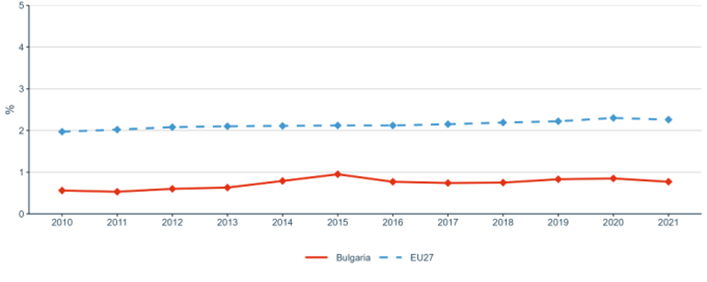

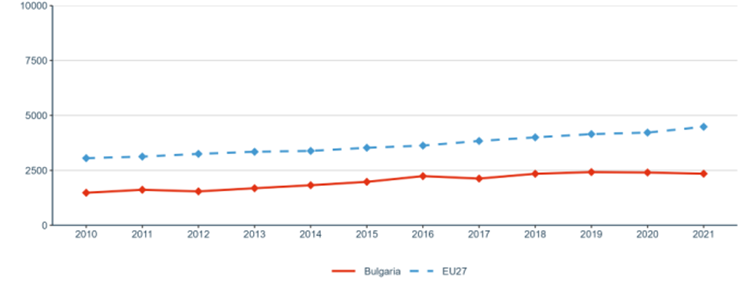

Priority 1: Deepening a truly functioning internal market for knowledge
Sub-priority 1.1: Open Science
Sub-priority 1.2: Research infrastructures
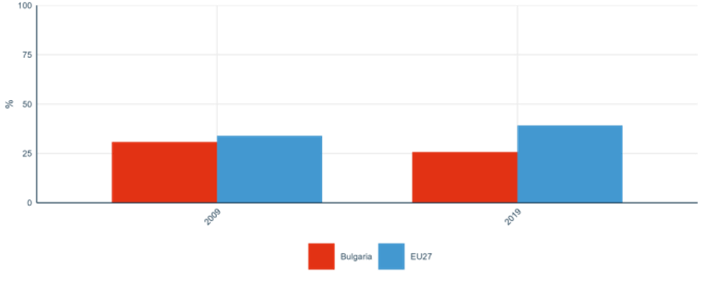
Sub-priority 1.3: Gender equality, equal opportunities for all and inclusiveness
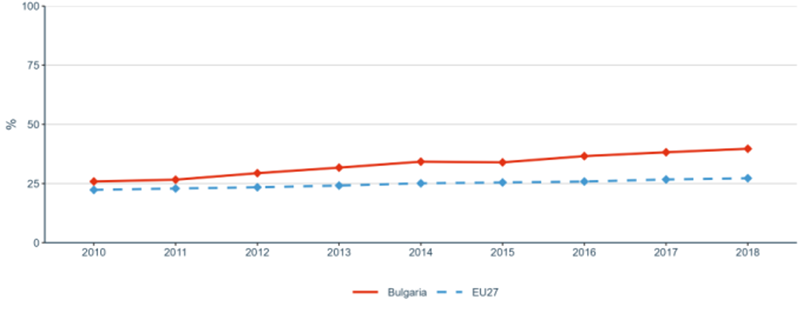

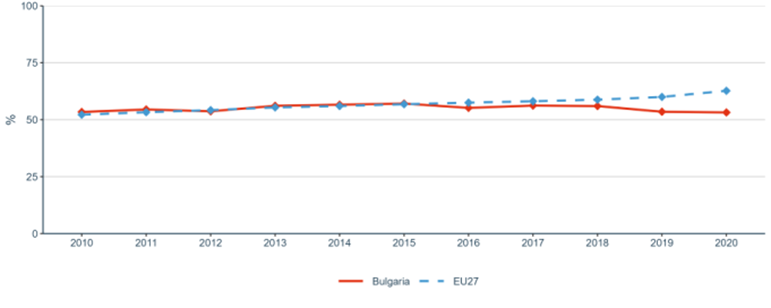
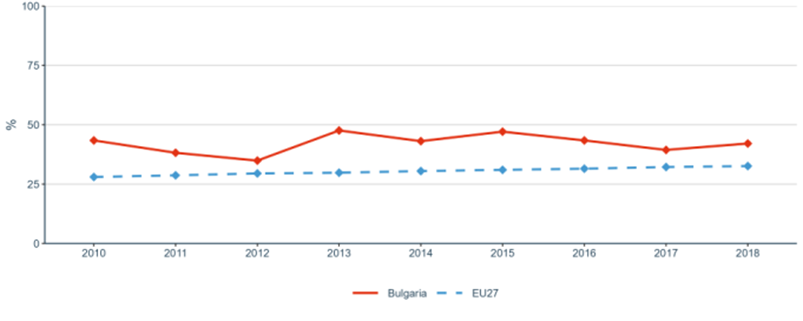

Sub-priority 1.4: Researchers’ careers and mobility and research assessment and reward systems

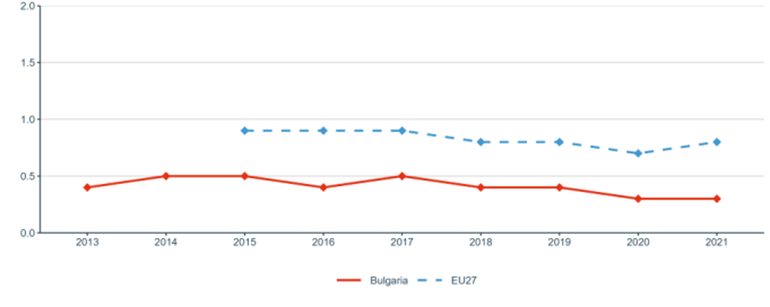

Sub-priority 1.5: Knowledge valorisation
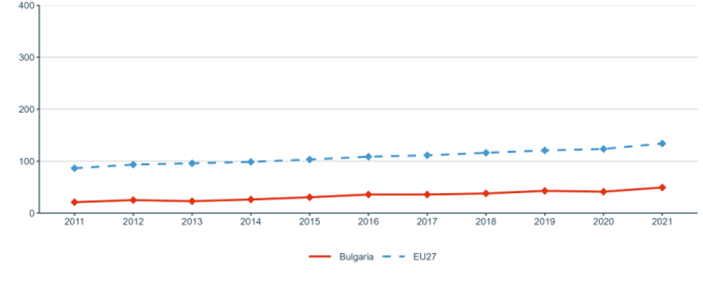

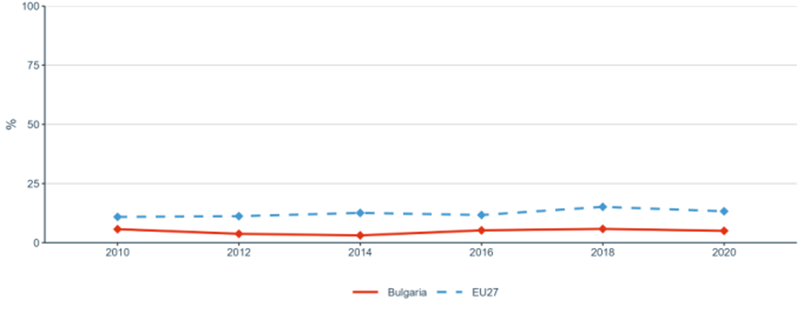
Sub-priority 1.6: Scientific leadership
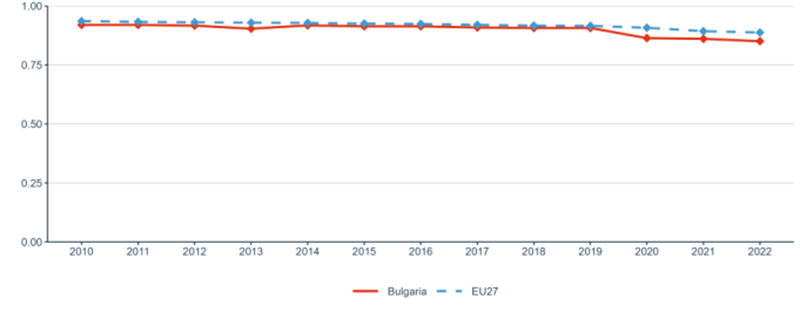

Sub-priority 1.7: Global engagement

Priority 2: Taking up together the challenges posed by the twin green and digital transition, and increasing society’s participation in the ERA
Sub-priority 2.1: Challenge-based ERA actions
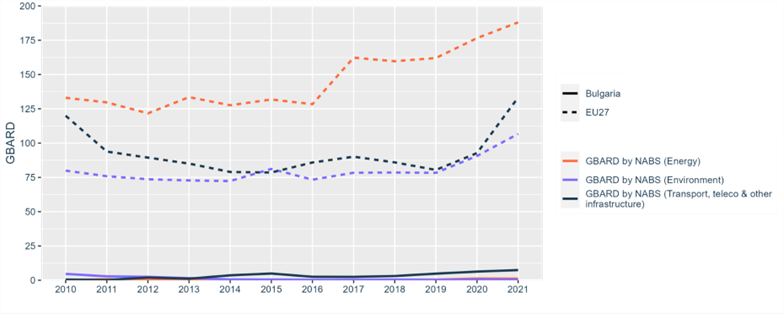

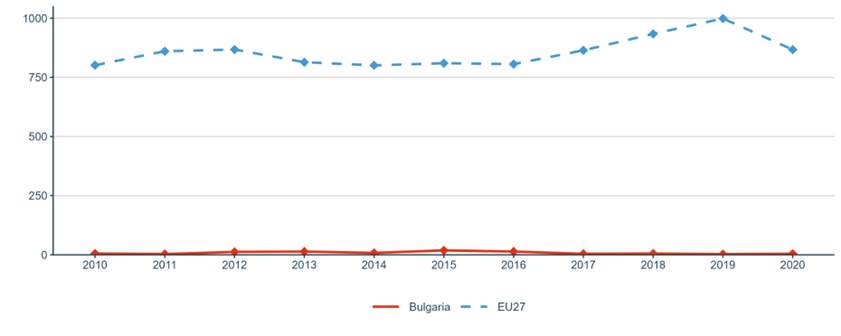
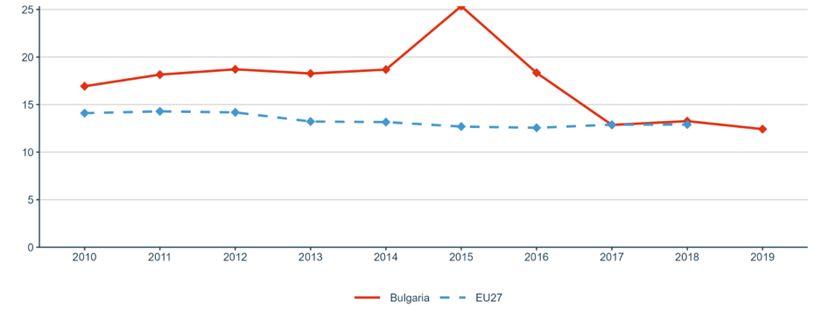
Sub-priority 2.2: Synergies with education and the European Skills Agenda
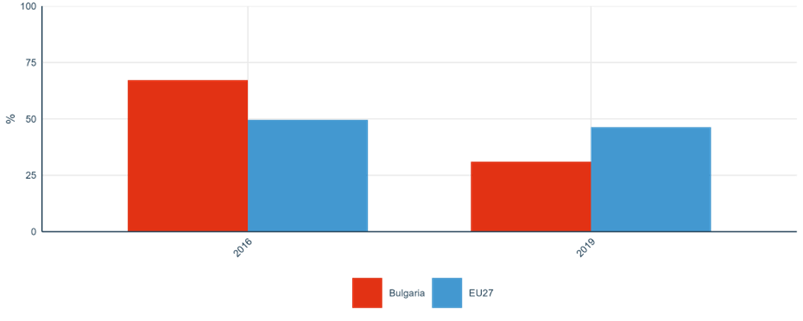
Sub-priority 2.3: Synergies with sectorial policies and industrial policy, in order to boost innovation ecosystems
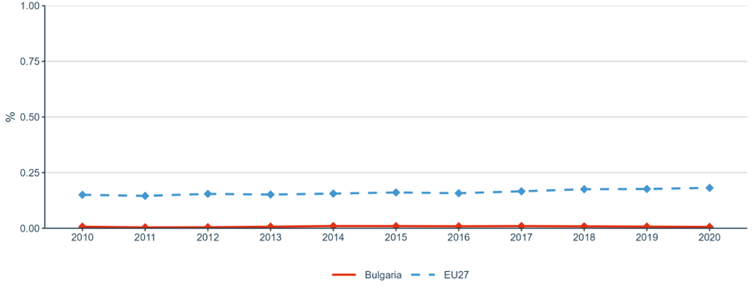
Sub-priority 2.4: An active citizen and societal engagement in R&I in all its dimensions
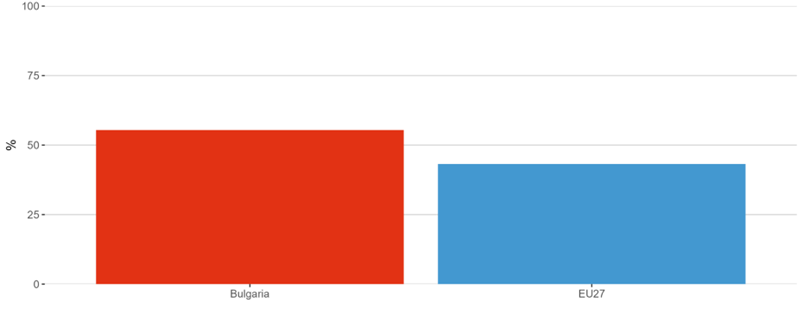
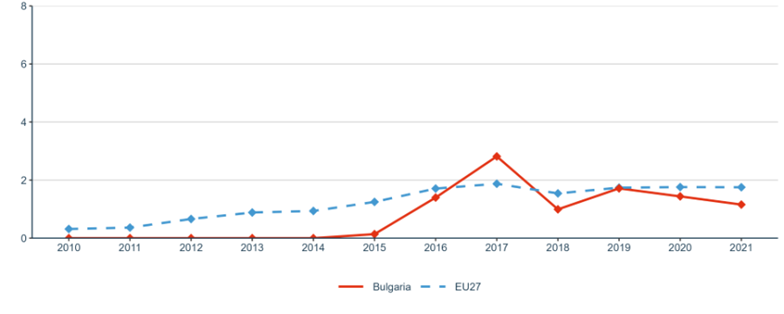
Priority 3: Amplifying access to research and innovation excellence across the Union
Sub-priority 3.1: More investments and reforms in countries and regions with lower R&I performance
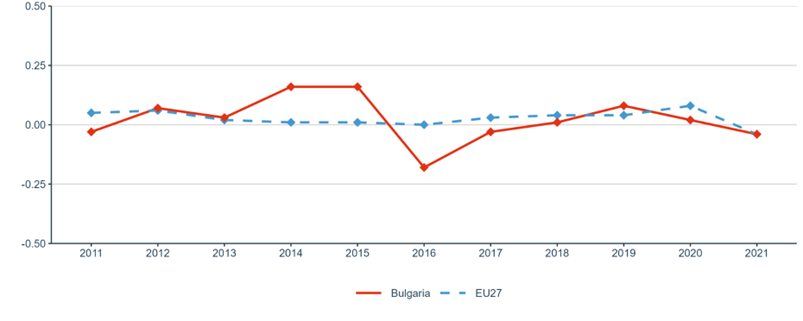
Priority 4: Advancing concerted research and innovation investments and reforms
Sub-priority 4.1: Coordination of R&I investments

